When you howl, your dog's response taps into deep-rooted instincts from their wolf ancestors. It's not just mimicry; it's a form of social bonding and communication. Your pup sees you as part of their pack, and howling together reinforces that connection. This behavior also serves as a way for dogs to express emotions, from excitement to curiosity. Some breeds are more prone to howling than others, but most dogs will respond to high-pitched sounds that trigger their instincts. Understanding this behavior can help you manage excessive howling and strengthen your bond with your furry friend. There's much more to uncover about your dog's vocal tendencies.
Origins of Canine Howling Behavior
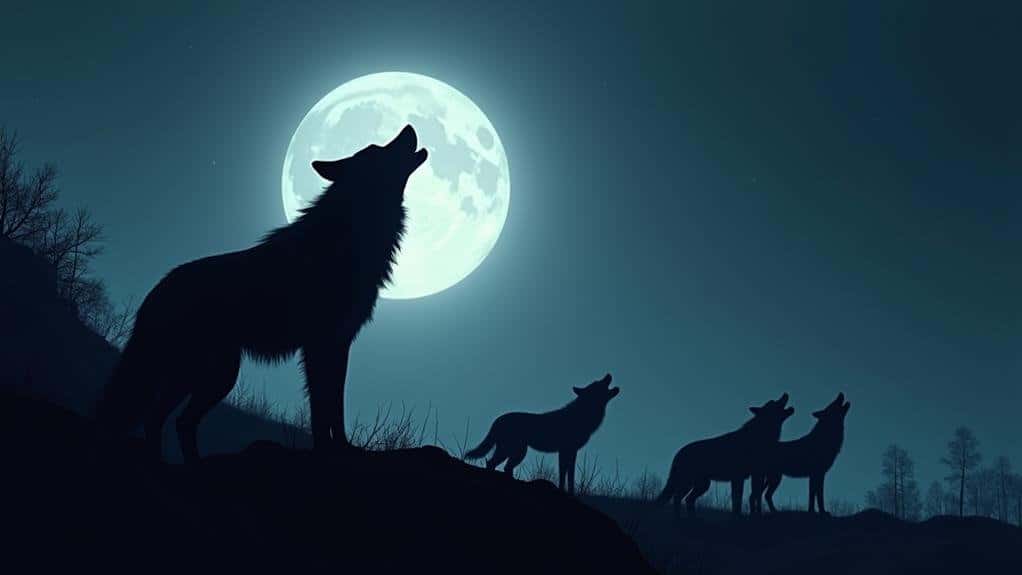
Your dog's howling behavior is a fascinating window into its wild ancestry. When you hear your furry friend let out a long, melodious howl, you're witnessing an ancient form of canine communication that dates back to their wolf predecessors.
Dogs howling behavior serves multiple purposes, rooted deeply in their ancestral instincts.
Understanding why dogs howl can help you better connect with your four-legged companion. Here are some key reasons behind this instinctual behavior:
- Long-distance communication: Dogs use howls to communicate over vast distances, just like their wolf ancestors.
- Territorial claims: Howling helps dogs assert their presence and mark their territory.
- Social bonding: Pack members often howl together, strengthening their social bonds.
- Response to high-pitched sounds: Your dog may howl when it hears sirens or even when you howl, mimicking the sound.
Social Bonding Through Vocal Mimicry
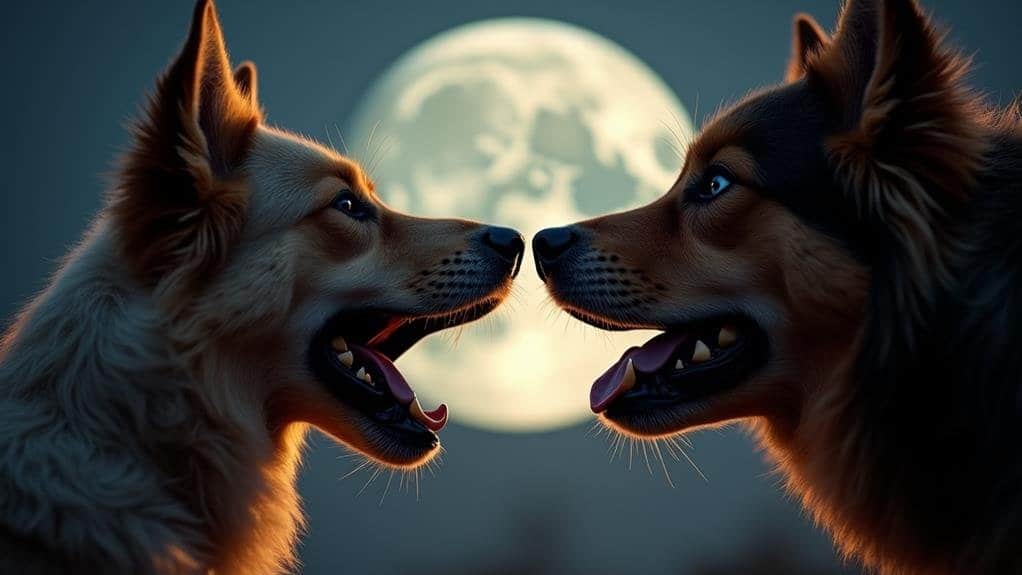
When you let out a playful howl and your dog joins in, you're witnessing a fascinating display of social bonding through vocal mimicry. This behavior taps into your furry friend's ancestral instincts, reminiscent of wild canines howling to connect with their pack members.
Your dog's response to your howling is more than just a cute trick; it's a form of emotional expression and communication. When you howl, your pup may interpret it as an invitation to join a communal activity, strengthening your bond.
This vocal exchange can trigger a chain reaction, especially in multi-dog households or neighborhoods, as one dog's howl often prompts others to chime in.
The Science Behind the Howl:
- Auditory sensitivity: Your dog's keen ears pick up on the pitch and tone of your howl, compelling them to respond.
- Social reinforcement: By howling together, you're reinforcing your status as part of the same "pack."
- Emotional connection: This shared activity can enhance your dog's sense of belonging and closeness to you.
Pack Mentality and Communication
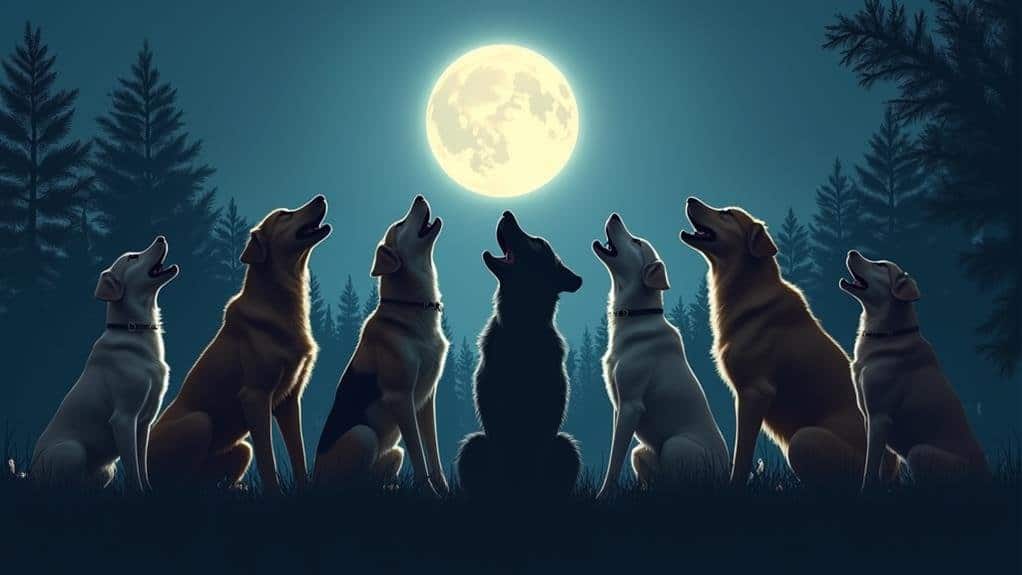
In accordance with their pack mentality, dogs use howling as a powerful tool for communication and social bonding. When you howl, your furry friend may interpret this as a signal for dogs to join in, triggering their instinctual desire to engage in social interaction.
This reciprocal behavior isn't just a cute quirk; it's deeply rooted in canine behavior and serves important functions:
- Communication: Dogs howl to communicate their presence, emotions, and needs to both their human family and other dogs in the area.
- Group cohesion: Howling is a form of vocal mimicry that reinforces social bonds within the pack, whether that pack includes humans or other canines.
- Emotional expression: Your dog's response to your howl can provide insights into their emotional state, potentially indicating excitement, anxiety, or a desire for attention.
Understanding this aspect of your dog's behavior can help you better interpret their needs and strengthen your bond.
Emotional Responses to Human Howling
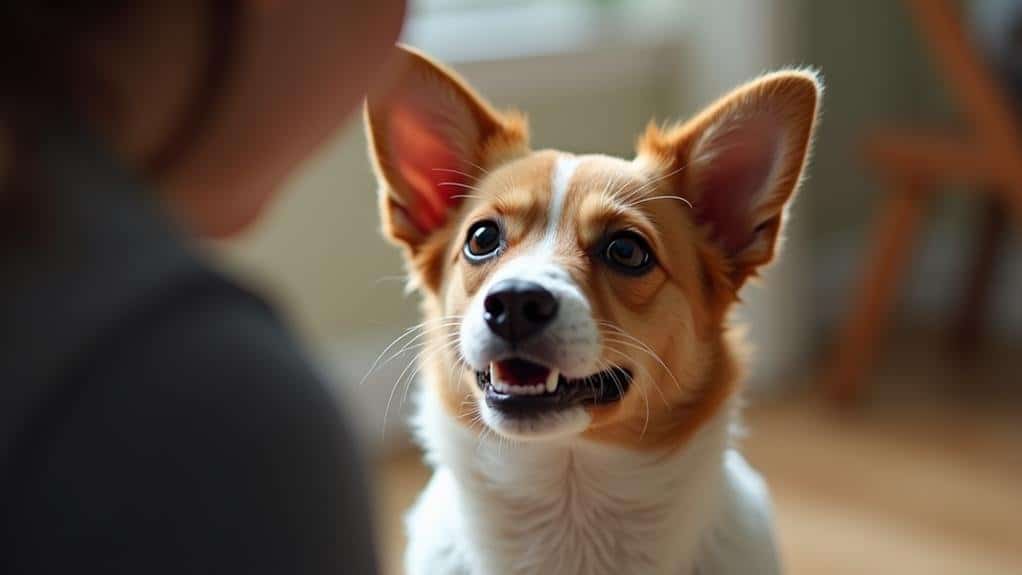
Responding to human howls, dogs exhibit a range of emotional responses that reveal their deep-seated social instincts.
When you howl, your furry friend might interpret it as an invitation to communicate, triggering their pack mentality. This can lead to some interesting reactions:
1. Curiosity and Excitement
Your dog may tilt their head, perk up their ears, or even approach you with enthusiasm. They're likely thinking, "What's this new game we're playing?"
2. Social Bonding
By howling back, your dog is attempting to strengthen your connection. It's their way of saying, "I hear you, and I'm part of your pack!"
3. Attention-Seeking
Sometimes, your dog's howl is a bid for attention. They might be thinking, "Hey, human companion, let's interact more!"
4. Emotional Expression
Dogs use vocalizations to express various emotions. Your howl could evoke feelings of excitement, confusion, or even mild concern in your pet.
Instinctual Triggers for Dog Howling
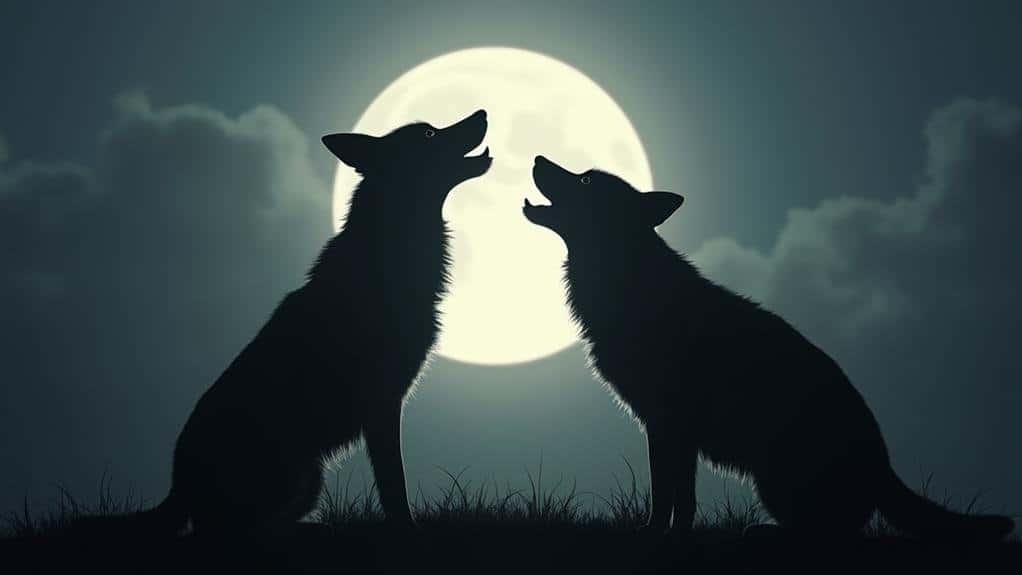
While your dog's response to human howling offers fascinating insights into their emotional world, it's equally important to understand what naturally triggers their own howling instincts.
Dogs are instinctively drawn to high-pitched sounds, including your own howls, because these noises mimic their ancestral communication methods.
When you howl, your furry friend perceives it as an invitation to join in, viewing it as a form of social engagement. This behavior is deeply rooted in their evolutionary past, where howling played a vital role in:
- Maintaining pack cohesion
- Alerting other members to their location
Your dog's response to your howl isn't just about mimicry; it's a complex interplay of instinct and social dynamics.
They may interpret your vocalization as:
- A call for attention
- A signal of excitement
This instinctive response can create a chain reaction, with one dog's howl triggering others to join in.
It's as if they're participating in a canine chorus, fostering a sense of connection among themselves and with you.
Understanding these instinctual triggers can help you better appreciate and manage your dog's howling behavior.
Attention-Seeking and Howling Patterns
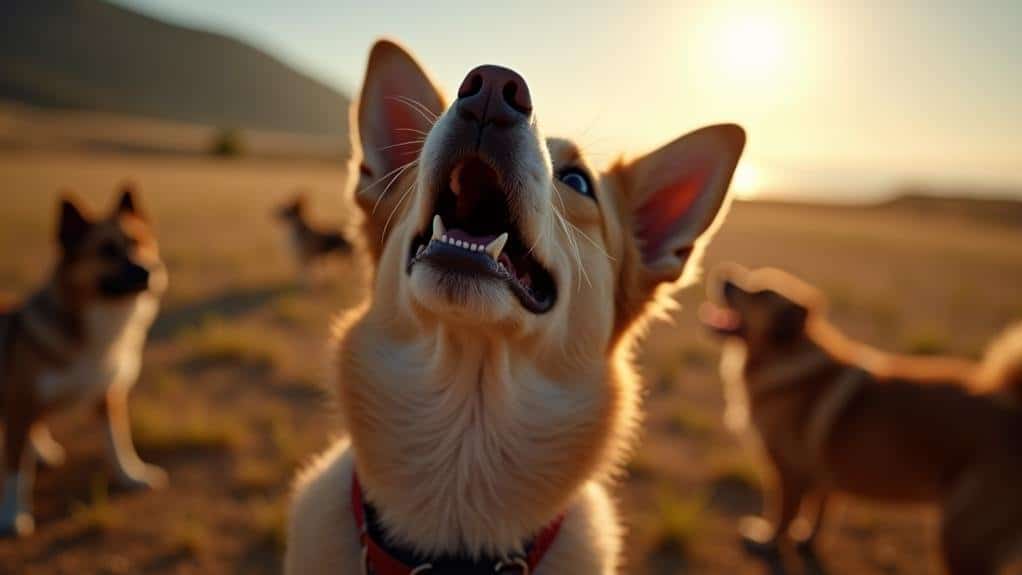
As you've likely noticed, your dog's howling isn't always a spontaneous outburst. When you howl, and your furry friend responds, it's often a clever attention-seeking behavior.
Dogs are social creatures, and they've learned that howling back is a great way to interact with you and grab your attention. This learned behavior is reinforced every time you respond to their howls. It's their way of saying, "Hey, I'm here! Let's communicate!"
Your dog's howl is a form of emotional expression, conveying excitement and a desire for connection. To better understand your dog's howling patterns, consider these factors:
- Breed differences: Some breeds, like Siberian Huskies, are more prone to howling.
- Frequency and volume: These can vary based on your dog's individual personality and learned behaviors.
- Your response: How you react to their howls can encourage or discourage this behavior.
As an owner, it's important to recognize when howling becomes excessive. You can guide your dog to quieter behaviors by:
- Acknowledging their howls briefly, then redirecting attention.
- Rewarding calm behavior.
- Providing alternative forms of engagement and mental stimulation.
Managing Your Dog's Howling Response

Managing your dog's howling response requires a balanced approach of patience and consistency. As you work on curbing excessive vocalizations, remember that it's essential not to inadvertently reward the behavior.
Instead, focus on positive reinforcement techniques to encourage quieter conduct.
Here are some effective strategies to manage your dog's howling:
- Identify triggers: Monitor what stimuli cause your dog to howl, such as sirens or music.
- Desensitization: Gradually expose your dog to these triggers in controlled settings.
- Provide distractions: Offer toys or engaging activities to redirect your dog's attention.
- Teach the "quiet" command: Consistently train your dog to stop howling on cue.
- Reward silence: Praise and treat your dog when they remain quiet in situations that typically trigger howling.
Frequently Asked Questions
Why Does My Dog Howl When He Hears Another Dog Howl?
Your dog howls in response to other dogs as a form of communication. It's an instinctive behavior rooted in pack mentality. They're joining in, asserting their presence, and reinforcing social bonds with other dogs in the area.
Is It Bonding to Howl With Your Dog?
Yes, it's bonding to howl with your dog. You're mimicking pack behavior, reinforcing your connection. It's a playful interaction that stimulates your dog mentally and emotionally. You're showing you understand their instincts, strengthening your relationship through shared communication.
Are Dogs Happy When They Howl?
Your dog's happiness during howling can vary. They're often joyful when responding to you, as it's a bonding activity. However, if they're howling due to anxiety or distress, they may not be happy. Observe their body language for clues.
Why Do Dogs Howl in Response to Sounds?
Your dog howls in response to sounds due to their heightened sensitivity to certain frequencies. They're instinctively reacting to what they perceive as howl-like noises, often triggering a communal response. It's their way of communicating and showing alertness.
Conclusion
You've now unraveled the mystery behind your dog's howling response! Remember, it's a natural behavior rooted in their wild ancestry and social instincts. By understanding the reasons behind this vocal mimicry, you can better connect with your furry friend. Whether it's bonding, communication, or attention-seeking, your dog's howl is their way of talking to you. So, the next time you howl and your pup joins in, you'll know exactly what's going on in their canine mind!

